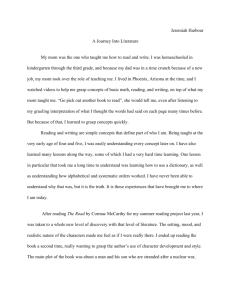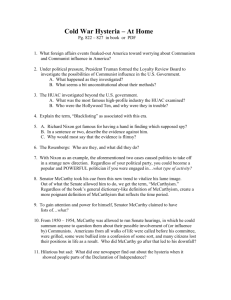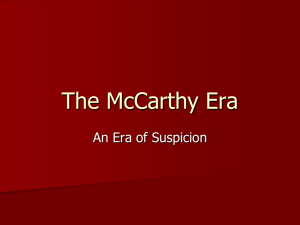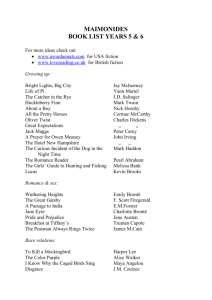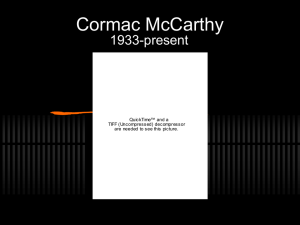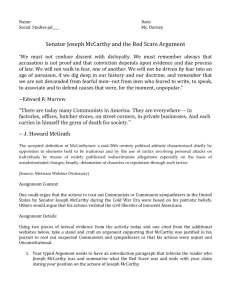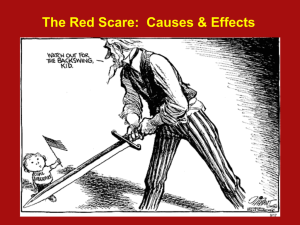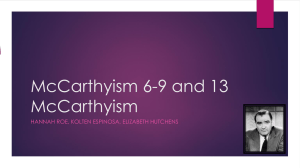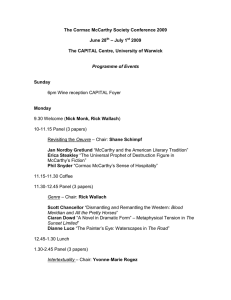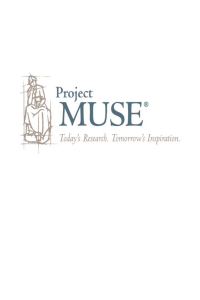The Road
advertisement
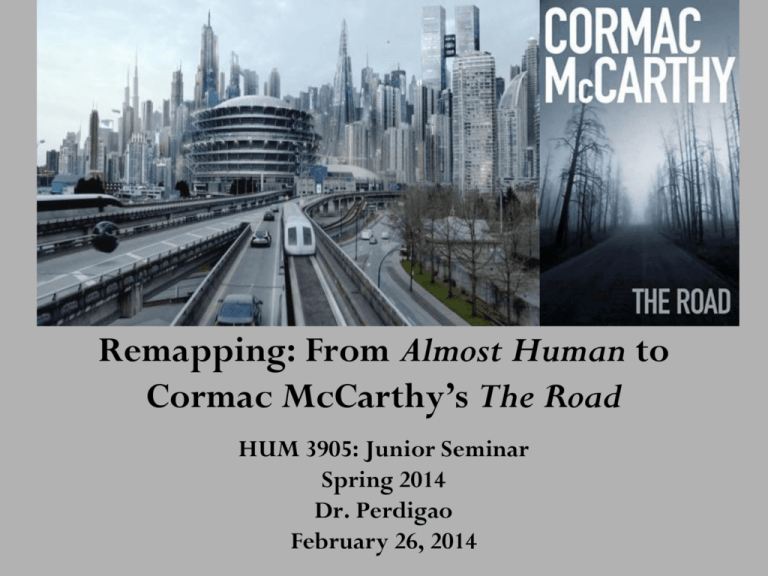
Remapping: From Almost Human to Cormac McCarthy’s The Road HUM 3905: Junior Seminar Spring 2014 Dr. Perdigao February 26, 2014 Interiority and Exteriority • Tim Armstrong, Modernism, Technology, and the Body • Study of the body in relation to modernity, literary modernisms • Site of crisis and meaning • Limits of the body, possibilities for augmentation • Fracturing, prosthetics • Idea of what it means to be human, what it means to be machine • From the assembly line to Almost Human • Prosthetic leg and “soul” chip Et tu, Rosie? • http://www.huffingtonpost.com/hulucom/10-fictional-robots-wedl_b_4277689.html • https://www.tate.org.uk/art/images/work/T/T00/T00249_10.jpg • http://i.telegraph.co.uk/multimedia/archive/01514/Nevinson1_1514892c.jp g • http://www.ottodix.org/pix/catalog/gallery/1920-war-cripples.gif • http://www.ottodix.org/pix/catalog/gallery/1920-PragerStrasse.jpg Reconfigurations • The “Wall” and the boundaries of the city • Insiders/outsiders • Efficiency in new models, unpredictability • Mirroring/rejecting humanity • Man as machine in new landscape • Mechanization of system, individuals • Joss Whedon’s Dollhouse (2009-2010), J. J. Abrams, Alex Kurtzman, and Roberto Orci’s Fringe (2008-2013), The CW’s The Tomorrow People (2013- ) • Eric Kripke’s Revolution (2012- ) McCarthyism Books • The Orchard Keeper (1965) • Outer Dark (1968) • Child of God (1974) • Suttree (1979) • Blood Meridian, Or the Evening Redness in the West (1985) • All the Pretty Horses (1992) • The Crossing (1994) • Cities of the Plain (1998) • No Country for Old Men (2005) • The Road (2006) Published screenplay and plays • The Stonemason: A Play in Five Acts (1994) • The Gardener’s Son: A Screenplay (1996); PBS film in 1977 • The Sunset Limited: A Novel in Dramatic Form (2006) McCarthyism Three unpublished screenplays • Whales and Men (n.d.) • Cities of the Plain (1984) • No Country for Old Men (began as screenplay in 1984) Two short stories • “Wake for Susan” (1959) • “A Drowning Incident” (1960) McCarthyism • All the Pretty Horses: New York Times bestseller, won National Book Award • The Road: Pulitzer Prize • Rockefeller Foundation Grant, Guggenheim Fellowship, and MacArthur Fellowship (“genius” grant) • Film adaptation of No Country for Old Men by Joel and Ethan Coen; won Oscars for Best Picture, Best Director, Best Adapted Screenplay, Best Supporting Actor for Javier Bardem Tracking McCarthy • Cormac McCarthy born in Rhode Island on July 20, 1933 • Named Charles after his father, renamed himself after the Irish King • Family moved to Knoxville in 1937; father a lawyer for Tennessee Valley Authority • Family moved to Washington, D.C. • Attended University of Tennessee in 1951-1952; joined U.S. Air Force in 1953, serving for four years, two stationed in Alaska • Returned to university from 1957-1959, published two short stories in The Phoenix (student magazine); won Ingram-Merrill Award for creative writing in 1959 and 1960 • Left university for Chicago, worked as auto mechanic and wrote first novel • Married Lee Holleman, settled in Tennessee, had one son Cullen, divorced Tracking McCarthy • Received fellowship from Academy of Arts and Letters in 1965 • Intended to visit Ireland, met Anne DeLisle who was working on the ship Sylvania and married her in England in 1966 • Rockefeller Foundation Grant (1966-1968); traveled to England, France, Switzerland, Italy, Spain; stayed in Ibiza; wrote Outer Dark • 1967 McCarthys returned to America; moved to Tennessee; Outer Dark published in 1968 • 1969 Guggenheim Fellowship for Creative Writing; purchased and renovated a barn • Separated from Anne in 1976, later divorced • MacArthur Fellowship, “genius grant,” in 1981 • Blood Meridian published in 1985, move to western writing • After editor retired, McCarthy moved from Random House to Knopf, resulting in more exposure Tracking McCarthy • Success of All the Pretty Horses • New York Times bestseller, selling 190,000 copies in hardcover within the first six months • The Crossing in 1994, with first run of 200,000 copies • Finishes the Border Trilogy in 1998 • Married Jennifer; moved to New Mexico; had son John, inspiration for The Road • Interest and work with the Santa Fe Institute, place of science within his fictional worlds—idea of the “logical” versus the “beautiful” http://www.cormacmccarthy.com/ Staging • Appalachia; southeast? http://web.utk.edu/~wmorgan/TR/route.htm • Searching for civilization • Survival versus compassion and empathy • At the Santa Fe Institute, questions about cause of destruction in The Road; speculations if it was a meteor but he says it could be volcanic activity or nuclear war • Emphasis on “what do you do?” (http://online.wsj.com/article/SB100014240527487045762045745297035772 74572.html) • Conversations between Cormac and his son; credits his son as being the coauthor of the book (for example, the question of what Cormac would do if John died) • Idea that things that are “universally” known are Coca-Cola, cowboys, and Indians, subjects of his writing The Non-Science • WSJ: When you discussed making “The Road” into a movie with John, did he press you on what had caused the disaster in the story? • CM: A lot of people ask me. I don't have an opinion. At the Santa Fe Institute I’m with scientists of all disciplines, and some of them in geology said it looked like a meteor to them. But it could be anything—volcanic activity or it could be nuclear war. It is not really important. The whole thing now is, what do you do? The last time the caldera in Yellowstone blew, the entire North American continent was under about a foot of ash. People who’ve gone diving in Yellowstone Lake say that there is a bulge in the floor that is now about 100 feet high and the whole thing is just sort of pulsing. From different people you get different answers, but it could go in another three to four thousand years or it could go on Thursday. No one knows. • (http://online.wsj.com/article/SB100014240527487045762045745297035772 74572.html) • Exposition • Major events • Conflict • Climax • Characterization Plotting • Constructions of family Themes • Trinity • Loss of mother • New Eden—Adam and Eve • Failed utopianism? • “good guys” versus “bad guys” (77); “we’re carrying the fire” (83) • Prometheus story for the postmodern, post-apocalyptic world? • State roads (43) • Place of the past, memories • Boy as key to the new world, new Adam • Lack of punctuation, gaps in narrative, use of pronouns Gray ash • “Then they set out along the blacktop in the gun-metal light, shuffling through the ash, each the other’s world entire” (6). • “He got the binoculars out of the cart and stood in the road and glassed the plain down there where the shape of a city stood in the grayness like a charcoal drawing sketched across the waste” (8). • “Bedrock, this. The cold and the silence. The ashes of the late world carried on the bleak and temporal winds to and fro in the void. Carried forth and scattered and carried forth again. Everything uncoupled from its shoring. Unsupported in the ashen air. Sustained by a breath, trembling and brief. If only my heart were stone” (11). • “Just remember that the things you put into your head are there forever, he said. You might want to think about that. You forget some things, dont you? Yes. You forget what you want to remember and you remember what you want to forget” (12). • “He thought if he lived long enough the world at last would be all lost. Like the dying world the newly blind inhabit, all of it slowly fading from memory” (18). Storytelling • “From daydreams on the road there was no waking. He plodded on. He could remember everything of her save her scent. Seated in a theatre with her beside him leaning forward listening to the music. Gold scrollwork and sconces and tall columnar folds of the drapes at either side of the stage. She held his hand in her lap and he could feel the tops of her stockings through the thin stuff of her summer dress. Freeze this frame. Now call down your dark and your cold and be damned” (19). • “He did not take care of her and she died alone somewhere in the dark and there is no other dream nor other waking world and there is no other tale to tell” (32). • “It’s the gap. This is it” (33). • Flashback to the beginning, the first years (28); to event (52-58) • “He banked the fire against the seam of rock where he’d built it and he strung the tarp behind them to reflect the heat and they sat warm in their refuge while he told the boy stories. Old stories of courage and justice as he remembered them until the boy was asleep in his blankets and then he stoked the fire and lay down warm and full and listened to the low thunder of the falls beyond them in that dark and threadbare wood” (41). • “Please dont tell me how the story ends” (75). Traces • “The tattered oilcompany roadmap had once been taped together but now it was just sorted into leaves and numbered with crayon in the corners for their assembly. He sorted through the limp pages and spread out those that answered to their location” (42). • “Who is it? said the boy. I dont know. Who is anybody?” (49). • “Are you a doctor? I’m not anything” (64). • “He’d carried his billfold about till it wore a cornershaped hole in his trousers. Then one day he sat by the roadside and took it out and went through the contents. Some money, credit cards. His driver’s license. A picture of his wife. He spread everything out on the blacktop. Like gaming cards. He pitched the sweatblackened piece of leather into the woods and sat holding the photograph. Then he laid it down in the road also and then he stood and they went on” (51). • “The names of things slowly following those things into oblivion. Colors. The names of birds. Things to eat. Finally the names of things one believed to be true. More fragile than he would have thought. How much was gone already?” (89). Palimpsests? • “Decidedly, The Road is not a tabula rasa, not a re-imagining from scratch; it takes what remains after the world has been destroyed and goes forward from there in search of what is next. And what we have in the novel’s style is the post-apocalyptic language of a simultaneously new and age-old work: a means of looking forward, to after, by seeking the basic forms again. The paradoxical achievement of McCarthy’s novel is that it accepts the disjunction between where the world/fiction has been and where it is going, and in this moment of possibility — after the old and before the new — reconciles barbarous destruction with eloquent hope” (69). • Kunsa, Ashley. “‘Maps of the World in Its Becoming’: Post-Apocalyptic Naming in Cormac McCarthy’s The Road. Journal of Modern Literature 33: 1 (1999): 57-74. JSTOR. Web. June 27 2011. • “The billboards had been whited out with thin coats of paint in order to write on them and through the paint could be seen a pale palimpsest of advertisements for goods which no longer existed” (128-129). Voicing over • Opening: Clocks stopping at 1:17 • Wife’s death: “There is no other tale to tell” • How things will be at the coast • Dreaming of bad things vs. good things; still fighting if dreaming of bad things • If he was God what he’d do with the world
